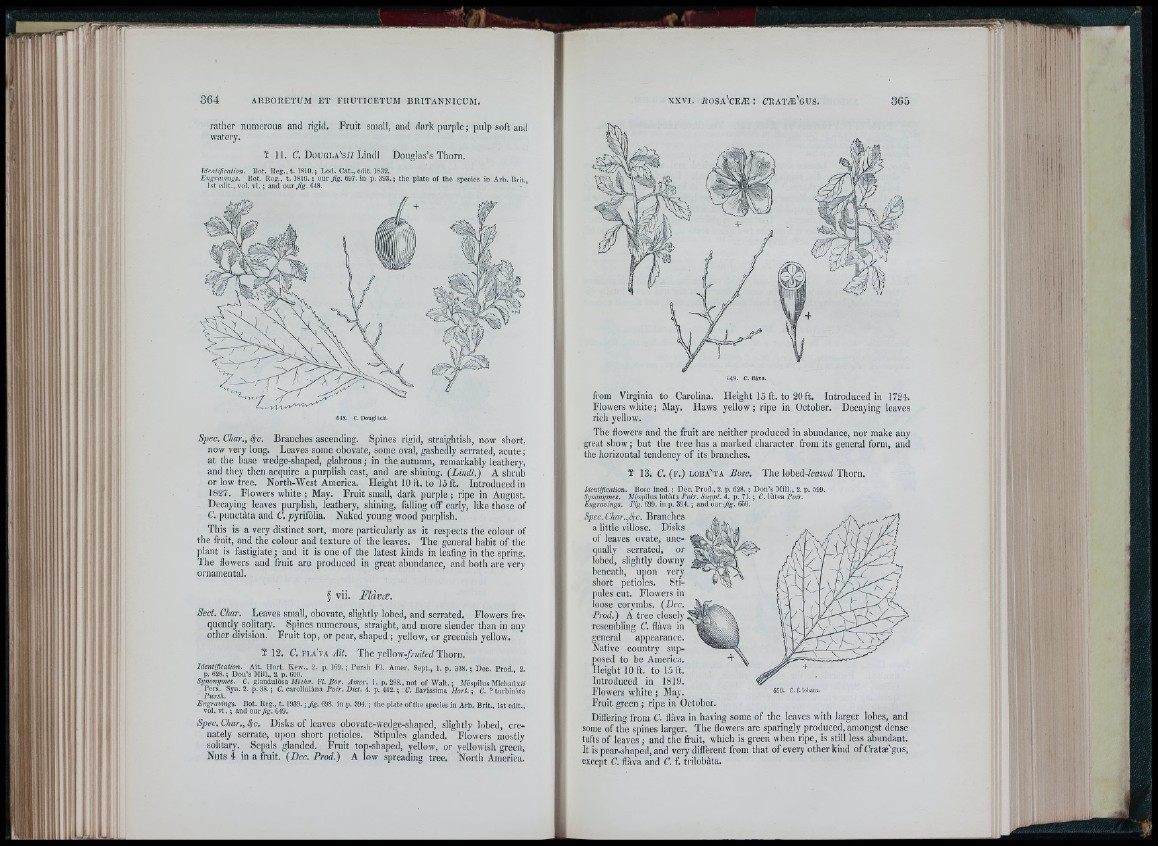
ratkei' numerous and rigid. F ruit small, and dark purple; pulp soft and
watei'y.
¥ I I . C . D o u g i . a ' s t / Lindl Douglas’s Thorn.
rdeMißcalion. Bot. Reg:., t. ISIO.; Lod. Cat., edit. 1832.
Eiigrnvings. Iiot. Reg., t. 1810. ; o u r /%. 007. in p. 393.; th e plate of th e species in Arh. Brit.,
1st edit., vol. vi. ; and our gig. 618.
61S. C. Dougltsii.
Spec, Char., 4c. Branches ascending. Spines rigid, straightish, now short,
now very long. Leaves some obovate, some oval, gashedly serrated, acu te ;
at the base wedge-shaped, glabrous; in the autumn, remarkably leathery,
and they then acquire a purplish cast, and are shining. (Lindl.) A shrub
or low tree. North-West America. Height 10 ft. to 15 ft. Introduced in
1827. F low e rsw h ite ; May. F ru it small, dark p urple ; ripe in August.
Dccayin« leaves purplish, leathery, shining, falling off early, like those of
C. punctata and C. yiyrifolia. Naked young wood purplish.
This is a very distinct sort, more particularly as it respects the colour of
the fruit, and the colour and texture of the leaves. The general habit of the
plant is fastigiate; and it is one of the latest kinds in leafing in the spring.
The flowers and fruit are produced in great abundance, and both are very
ornamental.
§ vii. Flàvre.
Sect. Char. Leaves small, obovate, slightly lobed, and serrated. Flowers frequently
solitary. Spines numerous, straight, and more slender than in any
other division. Fruit top, or pear, shaped ; yellow, or greenish yellow.
¥ 12. C. f l a ' v a ylif. The yellow./raited Thorn.
Identification. Ait. Hort. Kew., 2. p. 1G9. ; Pursh FI. Amer. Sept., 1 p 338 • Dec Prod 2
p. (528. ; Don’s MiJl., 2. p. 600. f •
Synonymes. C. glandulòsa MiWu’. FL Bor. Amer. 1. p. 288., not of Walt. : 3/cspilus Michadxu
P ers. Syn. 2. p. 38. ; C. caroliniàna Poir. Diet. 4. p. 442. ; C. flavissima Hort. i C. ? turbinàta
Pursh.
Engravings. Bot. Reg., t. 1939.; fig. 698, in p. 394.; the plate of th e species in Arb. Brit., 1st edit.,
vol. v i . ; and o u rjig . 649.
Spec. Char., 4c. Disks of leaves obovate-wedge-shaped, slightly lobed, crenately
serrate, upon short petioles. Stipules glanded. Flowers mostly
solitary. Sepals glanded. Fru • ^ ’ ^ ’ ^ ”. .... ^ . . . -
Nuts 4■ i' n sI fruit. (Dec. Prod.) A low spreading tree. North Anrerica.
'ruit top-sha[>ed,yellow, or yellowish green,
from Virginia to Carolina. Height 15 ft. to 20 ft. Introduced in 1724'.
Flowers white; May. Haws yellow; ripe in October. Decaying leaves
rich yellow.
The flowers and the fruit are neither produced in abundance, nor make any
great show; but the tree has a marked character from its general form, and
the horizontal tendency o f its branches.
Î 13. C. ( f . ) l o b a ' t a B o s c . The XohcàJeavcd Thorn.
Identification. Boec ined. ; Dec. Prod., 2. p. 628. ; Don’s Mill., 2. p. 599.
Stfrionymes. Méspilus lobata Poir. Sitppl- 4. p. 71. ; C. lùten Poir.
Èìigravings. Pig. 699. in p. 394. ; and oax jig . 650.
Spec.Char.,4c. Branches
a little villose. Disks
of leaves ovate, unequally
serrated, or
lobed, slightly downy
beneath, upon very
short petioles. Sti-
j)ules cut. Flowers in
loose corymbs. (Dec.
Prod.) A tree closely ^
resembling C. flava in
general appearance.
Native country supposed
to be America.
Height 10 ft. to 15 ft.
Introduced in 1819.
Flowers white ; May.
650. C. f. I’lUata.
Fruit green ; ripe in October.
Differing from C. flava in having some of the leaves with larger lobes, and
some of the spines larger. The flowers are sparingly produced, amongst dense
tufts of leaves ; and the fruit, which is green when ripe, is still less abundant.
It is pear-.shaped, and very different from that o f every other kind of Cratæ'gus,
except C. flàva and C. f. trilobàta.
I 1 !
L